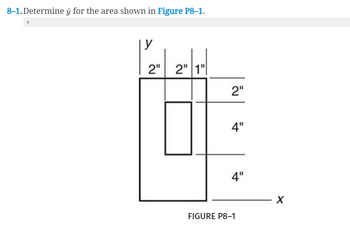
College Physics
11th Edition
ISBN: 9781305952300
Author: Raymond A. Serway, Chris Vuille
Publisher: Cengage Learning
expand_more
expand_more
format_list_bulleted
Concept explainers
Question

Transcribed Image Text:### Problem Statement
**8–1. Determine \( \bar{y} \) for the area shown in Figure P8–1.**
### Diagram Description
**Figure P8-1** is a geometric diagram that outlines a composite shape. It consists of two main rectangular areas with the following dimensions and placement:
- The full outer rectangle has dimensions of 5 inches in width (horizontally from left to right) and 10 inches in height (vertically from bottom to top).
- The height is divided as follows: a bottom part measuring 4 inches, a middle section of 4 inches, and a top part measuring 2 inches.
- The inner rectangle (which will be subtracted from the area) is centrally located.
- Its dimensions are: width 1 inch (horizontally) and height 4 inches (vertically).
- It is positioned 2 inches from the left side of the outer rectangle and 2 inches from the top.
Both \( x \) and \( y \) axes are drawn with the origin located at the bottom-left corner of the outer rectangle.
##### Additional Notes:
- The diagram includes various linear dimension labels to specify these distances, aiding in the understanding of the composite shape's distribution and balance.
### Determination of \( \bar{y} \)
To find \( \bar{y} \), the centroid of the area, we consider the dimensions and positions of the entire shape and the inner subtracted area.
Expert Solution
This question has been solved!
Explore an expertly crafted, step-by-step solution for a thorough understanding of key concepts.
Step by stepSolved in 2 steps with 1 images

Knowledge Booster
Learn more about
Need a deep-dive on the concept behind this application? Look no further. Learn more about this topic, physics and related others by exploring similar questions and additional content below.Similar questions
- A stone is thrown into a body of still water and created ripples in the form of concentric circles. If the radius increases at a rate of 2 m/s, at what rate is the area increasing when the radius is 2m? Group of answer choices a. 4 pi b. 8 pi c. 12 pi d. 6 piarrow_forward1. Using the figure below, answer the questions about the cross product ÀxČ. 60° A = 10.0 30° (a) Magnitude of Ả×č: Jà xč = X+ O X- O O +y O -y O +z (b) Direction of Axč:O -z C = 12.0arrow_forwardQ5arrow_forward
- The radius of Jupiter is about 69.0 x 103 km. The radius of the Sun is about 68.0 x 104 km. How many Jupiter volumes would fit inside the suns volume ?arrow_forwardA team in a Marshmellow challenge built a thrity inch tall structure in eighteen minutes. What is the average building speed of the team in inches per second? What will be the average speed in meters per second?arrow_forwardSome possibly useful numbers = 8.99 x 10° N-m²/C² €0 = 8.85 × 10-12C²/Nm² e = 1.6 × 10–19 C = 9.11 × 10-31kg mp = 1.67 x 10–27kg leV 1.6 x 10-19J %3Darrow_forward
arrow_back_ios
arrow_forward_ios
Recommended textbooks for you
 College PhysicsPhysicsISBN:9781305952300Author:Raymond A. Serway, Chris VuillePublisher:Cengage Learning
College PhysicsPhysicsISBN:9781305952300Author:Raymond A. Serway, Chris VuillePublisher:Cengage Learning University Physics (14th Edition)PhysicsISBN:9780133969290Author:Hugh D. Young, Roger A. FreedmanPublisher:PEARSON
University Physics (14th Edition)PhysicsISBN:9780133969290Author:Hugh D. Young, Roger A. FreedmanPublisher:PEARSON Introduction To Quantum MechanicsPhysicsISBN:9781107189638Author:Griffiths, David J., Schroeter, Darrell F.Publisher:Cambridge University Press
Introduction To Quantum MechanicsPhysicsISBN:9781107189638Author:Griffiths, David J., Schroeter, Darrell F.Publisher:Cambridge University Press Physics for Scientists and EngineersPhysicsISBN:9781337553278Author:Raymond A. Serway, John W. JewettPublisher:Cengage Learning
Physics for Scientists and EngineersPhysicsISBN:9781337553278Author:Raymond A. Serway, John W. JewettPublisher:Cengage Learning Lecture- Tutorials for Introductory AstronomyPhysicsISBN:9780321820464Author:Edward E. Prather, Tim P. Slater, Jeff P. Adams, Gina BrissendenPublisher:Addison-Wesley
Lecture- Tutorials for Introductory AstronomyPhysicsISBN:9780321820464Author:Edward E. Prather, Tim P. Slater, Jeff P. Adams, Gina BrissendenPublisher:Addison-Wesley College Physics: A Strategic Approach (4th Editio...PhysicsISBN:9780134609034Author:Randall D. Knight (Professor Emeritus), Brian Jones, Stuart FieldPublisher:PEARSON
College Physics: A Strategic Approach (4th Editio...PhysicsISBN:9780134609034Author:Randall D. Knight (Professor Emeritus), Brian Jones, Stuart FieldPublisher:PEARSON

College Physics
Physics
ISBN:9781305952300
Author:Raymond A. Serway, Chris Vuille
Publisher:Cengage Learning

University Physics (14th Edition)
Physics
ISBN:9780133969290
Author:Hugh D. Young, Roger A. Freedman
Publisher:PEARSON

Introduction To Quantum Mechanics
Physics
ISBN:9781107189638
Author:Griffiths, David J., Schroeter, Darrell F.
Publisher:Cambridge University Press

Physics for Scientists and Engineers
Physics
ISBN:9781337553278
Author:Raymond A. Serway, John W. Jewett
Publisher:Cengage Learning

Lecture- Tutorials for Introductory Astronomy
Physics
ISBN:9780321820464
Author:Edward E. Prather, Tim P. Slater, Jeff P. Adams, Gina Brissenden
Publisher:Addison-Wesley

College Physics: A Strategic Approach (4th Editio...
Physics
ISBN:9780134609034
Author:Randall D. Knight (Professor Emeritus), Brian Jones, Stuart Field
Publisher:PEARSON